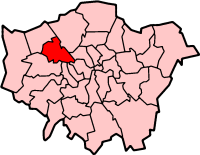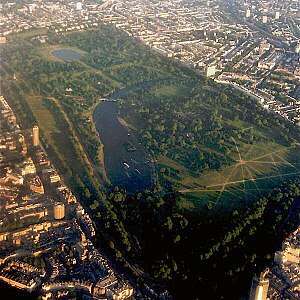Queen's Park, London
Queen's Park is an area and civil parish in North-West London located 3.9 miles (6.3 km) north-west of Charing Cross.[3] The northern half lies in the London Borough of Brent while the southern half lies in the City of Westminster.
| Queen's Park | |
|---|---|
 From top left to bottom right: The northern entrance to Queen's Park; Victorian houses on Chevening Road; The bandstand in Queen's Park; Queen's Park Post Office on Salusbury Road | |
 Queen's Park Location within Greater London | |
| Population | 15,281 (2011 Census. Brent Ward)[1] |
| OS grid reference | TQ246832 |
| • Charing Cross | 4 mi (6.4 km) SE |
| Civil parish |
|
| London borough | |
| Ceremonial county | Greater London |
| Region | |
| Country | England |
| Sovereign state | United Kingdom |
| Post town | LONDON |
| Postcode district | NW6 |
| Postcode district | W10 W9 |
| Dialling code | 020 |
| Police | Metropolitan |
| Fire | London |
| Ambulance | London |
| UK Parliament | |
| London Assembly | |
Known for family-friendly living,[3] the area is centred around a park of 30 acres (12 ha), which opened in 1887 and was named to honour Queen Victoria. The area takes its name from the park, and in turn gives its name to Queens Park Rangers football club.
Architecturally, Queen's Park is an important historic area, with a unified urban layout with a high level of building preservation. The park is a good example of a Victorian urban green space, and the surrounding streets largely comprise original two- and three-storey Victorian buildings.[4]
Geography
Administrative Background
Queens Park has never been an administrative unit and so it has never had formally defined boundaries; its northern part lies in Willesden (in the modern London Borough of Brent), while the south lies in Paddington (in the modern City of Westminster). These areas were a Municipal and Metropolitan Borough respectively, and have their origins in early medieval Ancient Parishes.
The area also included a detached 120 acre exclave of the parish of Chelsea which adjoined the boundaries of both Paddington and Willesden. This was in the vicinity of the (like Queens Park, also informally defined) Kensal Green and Kensal Town areas.[5]
All three of these parishes were in the Ossulstone Hundred of Middlesex. In 1855 the vestry of the Chelsea parish was incorporated as a local council in the metropolitan area of London governed by the Metropolitan Board of Works. Willesden parish remained outside the area and formed a local government district from 1874. In 1889 the area of the Metropolitan Board of Works that included the southern section of Queen's Park was transferred from Middlesex to the County of London. In 1900 the anomaly of the Chelsea exclave was removed by uniting it with the parish and borough of Paddington.[6][7]
In 1965, Paddington merged into the City of Westminster and Willesden became part of the new London Borough of Brent.
Like Queens Park, Kilburn is another informally defined area that spans the boundaries of more formally defined areas. Some areas of Queen’s Park are also sometimes described as part of Kilburn,
Neighbouring areas
Neighbouring areas include North Kensington to the south, Kensal Green to the west, Willesden to the north and Kilburn to the east. There is a degree of overlap in perceptions of the extent of these areas.
History
19th century
The area around Queen's Park was developed from 1875, and was named to honour Queen Victoria.[8] The open space opened in 1887, located to the north, also shares the name.[8]
In 1879 the Royal Agricultural Society annual show was held on the area which would become Queen's Park. The 100 acre site was chosen for its proximity to the railway network, Queen's Park Station having opened on 2 June 1879 on the main line from London to Birmingham, just in time to facilitate the movement of heavy machinery and stock. By the 1870s the annual shows had become major events and the Kilburn show was to be the largest ever held. The show was opened on 30 June 1879 by the Prince and Princess of Wales and saw an entry of 11,878 implements, 2,879 livestock entries and over 187,000 visitors. Poor weather and deep mud led to low attendance, but a visit by Queen Victoria on the fifth day, where she was driven on a specially constructed drive of ballast and brick from the new station along Salusbury Road on a route lined with cheering crowds, rallied visitors.[9]
In 1884 the North West London Park League was formed to secure the site as a people's park. The League appealed to the Ecclesiastical Commissioners not to sell the land for building until the future of the site could be assured as a public open space. In 1885 the Estates Committee of the Commissioners agreed to offer the use of the central portion of the land of 30 acres (12 ha) for public use and that the remaining portion of the site would be laid out as housing to derive the most benefit from the frontage onto the proposed park. The offer was to be made through the Lord Mayor to the City of London Corporation, conditional on Parliamentary sanction. At 3:00 p.m. 5 September 1887 Queen's Park officially opened with several thousand people present.[9]

The houses around Queen's Park were erected over a number of years starting with the north side of Harvist Road of which the majority were completed by 1899.[4] The west side of Chevening Road was also under construction in 1899 by local builders Bennet and Gimbrett to the design of G A Sexton. Many builders contributed to the estate which helped to generate the varied architectural character that can be seen on Kempe, Keslake and Chamberlayne Roads.[4]
The football team Queens Park Rangers was formed in Queen's Park in 1886, and became a professional team in 1889.[10]
20th century
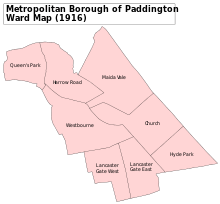
In 1915 the Bakerloo Line was extended to Queen's Park station.,[9] the nearby Kensal Green station appearing in 1916. Both stations offer easy access to Paddington, Charing Cross and Waterloo mainline stations [11]
In 1917 Queens Park Rangers moved away from the area to the Loftus Road stadium in nearby Shepherd's Bush.
In summer 1979 The Jam recorded their music video When You're Young in Queen's Park, making use of the bandstand.[12]
In 1986 Brent Council with the support of English Heritage made the area around Queen's Park a Conservation Area in recognition of its special architectural and historic character. Subsequently, in 1993 the designated area was extended westwards towards Chamberlayne Road.[4]
Governance
The area give its name to two electoral wards, which unusually are both named Queen's Park since they belong to two different London boroughs. The area north of Kilburn Lane is the Queen's Park ward of the London Borough of Brent, while the area south of Kilburn Lane is the Queen's Park ward of the City of Westminster.
Queen's Park (London Borough of Brent)
The Queen's Park ward in the south-east of the London Borough of Brent is represented by three Labour Party councillors on Brent London Borough Council as of the 2018 election.[13] This ward forms part of the Hampstead and Kilburn constituency, represented by Labour MP Tulip Siddiq.
Queen's Park (City of Westminster)
The Queen's Park ward in the north west of the City of Westminster is represented by three Labour Party councillors on Westminster City Council.[14] This ward forms part of the Westminster North parliamentary constituency, represented by Labour MP Karen Buck. In May 2012 residents of the ward voted in favour of the establishment of a Queen's Park civil parish and parish council.
In June 2012, Westminster City Council approved the establishment of the first civil parish created in London since new legislation was enacted in 2007.[15] The first election of councillors to Queens Park Community Council took place in May 2014 at the same time as other local elections.[16][17] Subsequent elections will be held every four years at the same time as elections to the City Council with a new Parish Council being elected as part of the 2018 Westminster City Council election .
The park

The park was laid out by Alexander McKenzie between March 1887 and June 1887. McKenzie was a leading figure in Victorian park design, part of an influential group of landscape designers which included Robert Marnock, Joseph Meston and William Robinson who led garden design away from the parterres and geometry of earlier Victorian gardens to a more natural style of gardening.[9]
Designed without any straight paths, Queen's Park makes extensive use of bold tree planting and shrubberies with natural outlines, and large open areas of lawn for recreation and sport.[9]
Facilities in the park include six all-weather tennis courts, a pitch-and-putt course, an ornamental quiet garden, a children's playground with paddling pool, a children's animal farm and a cafe.
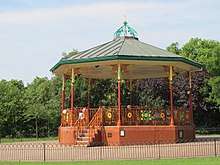
A landmark in the park is the bandstand, which was completed in 1887 using ironwork supplied by Walter Fariane & Co. of Glasgow, and a timber roof with wrought-iron scrolled devices to each facet, and a central wrought- iron lantern. The bandstand was Grade-II listed in 2000.[18]
The park is managed by the City of London Corporation. In 2014 it won Green Flag status for the 18th year in a row, and an additional Green Heritage Site award for its care and conservation of open space and facilities.[19]
The City of London focuses on sustainable management, recycling as much waste as possible. Grass clippings and wood are used to make mulch for shrubberies; everyday waste like cans, bottles and plastics are separated and recycled. Residents bring in their Christmas trees which are mulched and return for use on their own gardens. Rain water is recycled via a new drainage system. All water runs into a holding tank underground and can be pumped to various areas when needed.[20]
Places of worship

Queen's Park has a range of places of worship:
- St Anne with Holy Trinity, Brondesbury (Church of England)
- Church of The Transfiguration (Roman Catholic)
- West Kilburn Baptist Church
- Imam Khoei Islamic Centre
Culture
The local community host two annual festivals at Queen's Park.
- Queen's Park Day in September brings together a funfair, stalls for local community groups and shops, various entertainments (including acrobats and bird of prey displays) and live music hosted by the Rhythm Studio who foster young bands and singers in the Queens Park area.
- The Queen's Park Book Festival, in June, mixes national and international writers with local writing groups as part of the growing book festival movement across England.
Economy
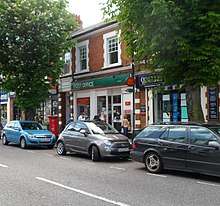
The economic centre of Queen's Park is Salusbury Road, where there are many shops, pubs, cafes and restaurants.
The weekly Queen's Park Farmers' Market has around 40 stalls and takes place every Sunday between 10am and 2pm in the grounds of Salusbury Primary School on Salusbury Road, draws people from across north west London. The market was awarded market of the year at the Farmers’ Market and Retail Association Local Food Awards in 2012.[21]
AMC Networks opened a 25,000 square feet (2,300 m2) UK headquarters office housing 200 employees on Salusbury Road in 2017.[22]
Education
The area has various schools:
- Salusbury Primary School
- Islamia Primary School, established in 1983 by Yusuf Islam, a voluntary-aided Islamic faith school that educates around 390 pupils aged 4 to 11.[23]
- Al-Sadiq and Al-Zahara Schools
- Queen's Park Primary School
- Wilberforce Primary School
- Hopscotch Under 5's
Transport
Queen's Park station is a tube and Network Rail station in Travelcard Zone 2; it has direct links to south and central London via the Bakerloo line or to Euston, Watford Junction and intermediate stations via London Overground trains or to Harrow & Wealdstone station using Bakerloo line trains. Brondesbury Park station, on the London Overground North London Line, is near the northeast corner of Queen's Park.[24][25]
Notable residents
- Alison Brooks - architect[26]
- Lily Allen - singer / songwriter and author
- Daniel Craig - actor[27]
- Jason Isaacs - actor[27]
- Sienna Miller - actress[28]
- Cillian Murphy - actor[29]
- Thandie Newton - actress[30]
- Michael Page - professional boxer and mixed martial artist[31]
- Alexandra Shulman - ex-editor of British Vogue[28]
- Zadie Smith - author[27]
- Fredo, rapper and musician
References
- "Brent Ward population 2011". Neighbourhood Statistics. Office for National Statistics. Retrieved 19 October 2016.
- "Queen's Park - Community Council". www.queensparkcommunitycouncil.gov.uk.
- Thorpe, Caroline. "Queen's Park's green space lures affluent professionals". The Financial Times. Retrieved 4 September 2017.
- http://democracy.brent.gov.uk/documents/s14308/Queens
- On the location of the former Chelsea exclave https://www.genuki.org.uk/big/eng/MDX/Paddington/churches
- "Historical Records of Westminster City Council". Westminster City Council. Archived from the original on 26 December 2010. Retrieved 18 January 2011.
- British History Online https://www.british-history.ac.uk/vch/middx/vol9/pp173-174
- Mills, A.D. (2001). Dictionary of London Place Names. Oxford.
- "A History of Queen's Park" (PDF). City of London Corporation. Retrieved 6 September 2017.
- "Our History – Key dates". Queens Park Rangers. Retrieved 27 August 2016.
- "Queen's Park and Kensal Client Case Study". London Property Match. Retrieved 15 December 2017.
- "Spotify Sunday: Going underground with The Jam". The Spectator. Retrieved 23 October 2019.
- "Your councillors by Ward". Brent Council. Retrieved 19 July 2018.
- "Archived copy". Archived from the original on 10 October 2009. Retrieved 21 January 2011.CS1 maint: archived copy as title (link)
- "Queen's Park parish council gets go-ahead". BBC News London online. London. 29 May 2012. Retrieved 29 May 2012.
- Derounian, James (2 February 2014). "Queen's Park: home of London's first parish council". The Guardian.
- "X Marks the Spot for London's First Parish Council". Local Council Review. 29 April 2014. Archived from the original on 27 May 2014.
- Historic England. "BANDSTAND IN QUEENS PARK (1382063)". National Heritage List for England. Retrieved 6 September 2017.
- King, Lorraine. "Green Flag status and heritage award for Queen's Park". Brent & Kilburn Times.
- "Management - City of London". www.cityoflondon.gov.uk.
- Brady, Tara. "Queen's Park Farmers' Market scoops top award". Brent & Kilburn Times.
- "A Tour of AMC Networks' New London Office". Officelovin'.
- "Prince goes pop to praise school". BBC News. 10 May 2000. Retrieved 17 May 2013.
- Snow, L. (2006). Queen's Park, Kensal, Brondesbury and Harlesden : a pictorial history. Chichester, West Sussex, England : Phillimore, 2006.
- Anthea, M. (2016, August 3). Spotlight on Queen's Park. Evening Standard. p. 28.
- "Trade knowledge:award-winning architect Alison Brooks's interior design tips and favourite London furniture shops". 20 November 2018 – via standard.co.uk.
- "Grunge and glamour meet in Queen's Park". 18 March 2011 – via www.thetimes.co.uk.
- "Subscribe to read". Financial Times.
- "CILLIAN MURPHY ON THE RETURN OF PEAKY BLINDERS". www.theresident.co.uk.
- "Subscribe to read". Financial Times.
- "Fearless – Michael 'Venom' Page mini documentary". whoatv.com. 16 February 2015.
External links
- Queens Park Area Residents' Association
- Queens Park Day
- City of London Corporation – Queen's Park
- Queens Park Community Council
